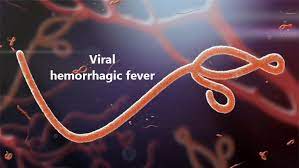Viral hemorrhagic fevers (VHFs) are a group of illnesses caused by four families of viruses. These include the Ebola and Marburg, Lassa fever, and yellow fever viruses. VHFs have common features: they affect many organs, they damage the blood vessels, and they affect the body’s ability to regulate itself. Some VHFs cause mild disease, but some, like Ebola or Marburg, cause severe disease and death.
VHFs are found around the world. Specific diseases are usually limited to areas where the animals that carry them live. For example, Lassa fever is limited to rural areas of West Africa where rats and mice carry the virus.
The risk for travelers is low, but you should avoid visiting areas where there are disease outbreaks. Because there are no effective treatments for some of these viral infections, there is concern about their use in bioterrorism.
These diseases most commonly occur in tropical areas. In the United States, people who get them usually have recently traveled to one of those areas.
There’s no cure for viral hemorrhagic fevers. There are vaccines for only a few types. Until additional vaccines are developed, the best approach is prevention.
Symptoms
Signs and symptoms of viral hemorrhagic fevers vary by disease. In general, early signs and symptoms can include:
- Fever
- Fatigue, weakness or general feeling of being unwell
- Dizziness
- Muscle, bone or joint aches
- Nausea and vomiting
- Diarrhea
Symptoms that can become life-threatening
More-severe symptoms include:
- Bleeding under the skin, in internal organs, or from the mouth, eyes or ears
- Nervous system malfunctions
- Coma
- Delirium
- Kidney failure
- Respiratory failure
- Liver failure
Causes
Viral hemorrhagic fevers are spread by contact with infected animals or insects. The viruses that cause viral hemorrhagic fevers live in a variety of animal and insect hosts. Most commonly the hosts include mosquitoes, ticks, rodents or bats.
Some viral hemorrhagic fevers can also be spread from person to person.
Stayed tune tomorrow learning more in Part II on Hemorrhagic Fever!

